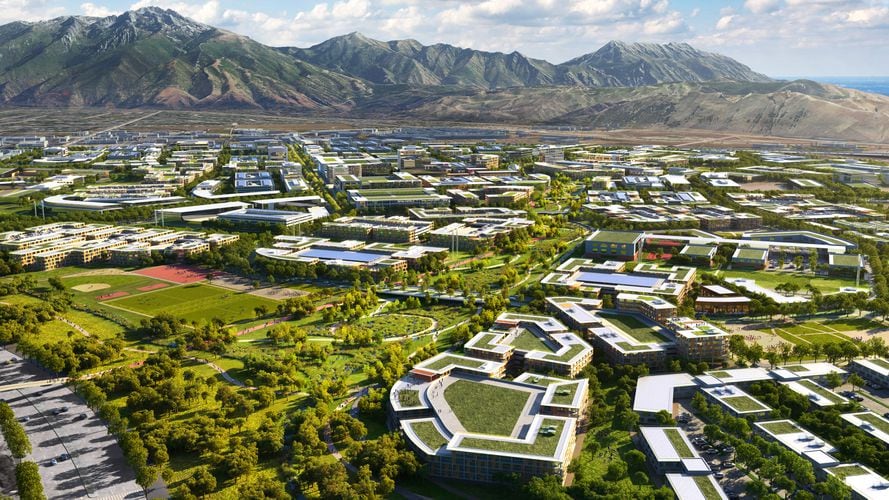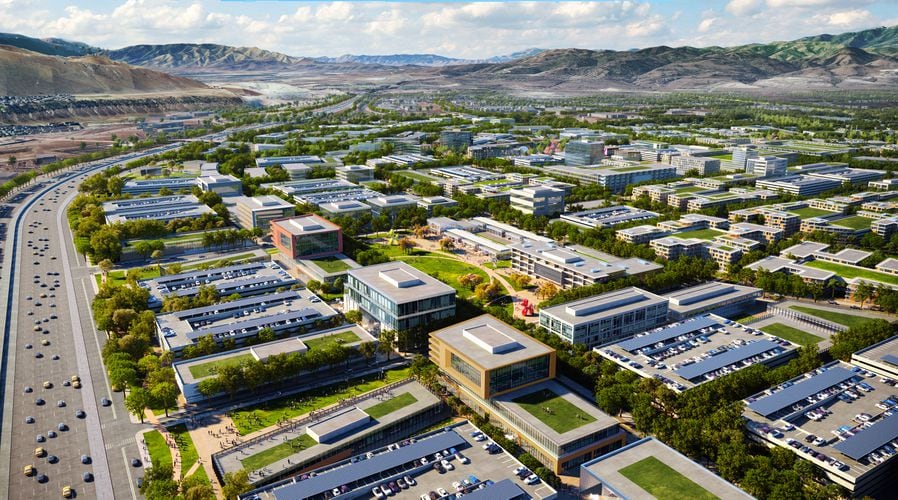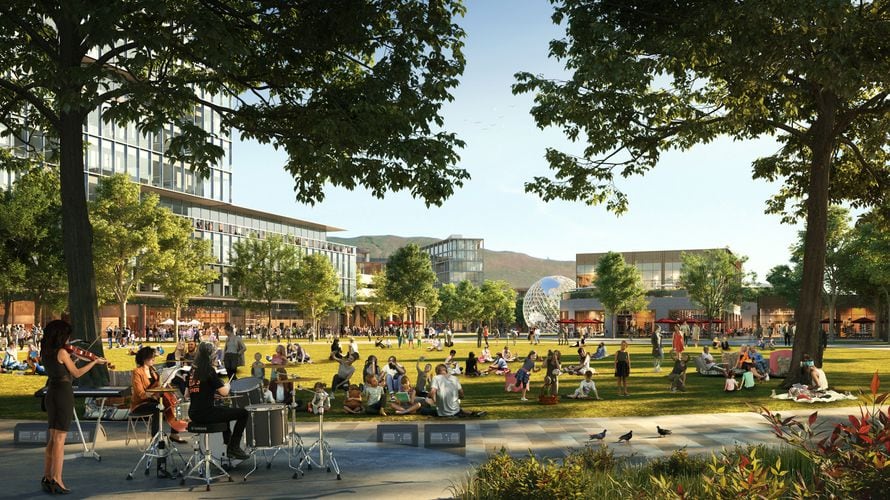State officials added fresh details Tuesday to one of the biggest government-backed land developments in Utah history.
The latest plans for The Point, as they’ve named the soon-to-be vacated Draper site of the Utah State Prison, aim to make it a regional model for mixing green spaces and trails with lots of housing, office towers and retail outlets in a way that lures new residents to the area and fosters widespread economic development.
Approved on Tuesday by Point of the Mountain State Land Authority, the new block-by-block framework for those 605 or so acres also calls for The Point to be environmentally sustainable for generations to come, deploying a pedestrian-friendly layout, rapid-transit buses and robotic vehicles to slash car usage, and giving a major ecological lift to portions of the adjacent Jordan River.

(Rendering by Skidmore, Owings & Merrill, via Point of the Mountain State Land Authority) Residential neighborhoods in The Point, a Utah-backed housing and economic development project proposed on 600 state-owned acres at Point of the Mountain in Draper. The land is to be vacated by Utah State Prison when that facility is moved to Salt Lake City sometime in 2022.
Estimates are The Point eventually would be home to roughly 14,800 residents, slightly larger than the nearby city of Bluffdale. The massive project also is expected to create tens of thousands of higher-paying jobs and trigger technological innovation.
Planners say they’ve stayed true to the idea of forming a self-sufficient “15-minute city” along that suburban stretch of Interstate 15 between Utah and Salt Lake counties, with everything those residents might need to live, work and recreate.
“Our goals have been high, and appropriately so, as this is a public site,” Alan Matheson, The Point’s executive director, said shortly after the new framework’s release.
He and others hope the plan will also spur and guide new development on hundreds of privately held acres adjoining the existing penitentiary, which has housed inmates since the mid-1950s.

(Rendering by Skidmore, Owings & Merrill, via Point of the Mountain State Land Authority) A residential area to be known as Wasatch District in The Point, a Utah-backed housing and economic development project proposed on 600 state-owned acres at Point of the Mountain in Draper. The land is to be vacated by Utah State Prison when that facility is moved to Salt Lake City sometime in 2022.
State and city leaders have scheduled a public open house Thursday to vet the latest approach to be held at Fred House Training Academy, 14727 S. Minuteman Drive in Draper. According to organizers, participants can dial in online or attend in person, from 4 to 7 p.m., with more details available at https://thepointutah.org.
This fifth iteration of plans for the state-owned acreage has been drafted after scores of public meetings, surveys and meetings by hired consultants and other experts over nearly two years. There are more studies to come, Matheson said, as the Point of the Mountain State Land Authority hones in what it will ultimately require of prospective private developers who contract to build The Point.
That could start happening next year, officials predict, once a replacement prison being constructed on the western edge of Salt Lake City is more fully operational and existing correctional facilities in Draper are eyed for demolition.
The Point’s framework already has several defining elements, many suggested by the public, that set it apart it amid a historic burst of new commercial and residential construction currently underway across the Salt Lake Valley.

(Rendering by Skidmore, Owings & Merrill, via Point of the Mountain State Land Authority) A central park envisioned at the heart of The Point, a Utah-backed housing and economic development project proposed on 600 state-owned acres at Point of the Mountain in Draper. The land is to be vacated by Utah State Prison when that facility is moved to Salt Lake City sometime in 2022.
Among these signature features:
• The project’s “main driver,” as one top planner put it, is to create economic growth, benefiting all Utahns. So it’s carved into seven districts, each serving an aspect of that goal, with about 40% of total land going to housing of various types and the rest for office, retail, institutional and mixed uses, as well as an innovation district.
The plan’s central district, to be called The Hub, would feature world-class entertainment options and a host of new restaurants. Housing would be concentrated on the west side of The Point, with offices, retail and similar land uses centered on the east.
• The latest framework is sensitive to environmental concerns, part of a “range to river” approach for the entire site linking the Jordan River Parkway with hiking, biking and other recreation opportunities in the foothills of the Wasatch Mountains. Planners have also set a high bar for conserving and recycling water and solid waste, reducing carbon emissions and creating a community less reliant on automobiles.
• The Point would exploit mass transit and multiple ways of getting around as few Utah developments have. That includes a carefully planned street grid heavy on bicycle and pedestrian corridors as well as several major new roads cutting through the area. There would be two bus rapid-transit lines running along dedicated road corridors tied to nearby FrontRunner stations, along with several potential circulator routes served by self-driving vehicles.
The aim: creating a “one-car” community, where households don’t need more than one vehicle and roughly 80% of residents are less than a 10-minute walk from a bus line. According to Draper Mayor Troy Walker, who has endorsed the latest vision, at The Point, “the car will not be king.”
• Nearly 142 acres at The Point, or a quarter of its total footprint, will be devoted to open space in a series of interlinked trails and parks of varying sizes spread through the project, with a major thoroughfare connecting everything to the shores of the Jordan River. That includes a central park intended as a tree-canopied community gathering space.
• Several supporters said that as a state-owned development, The Point also won’t be driven purely by profit motive, allowing it to unfold on a timeline “that raises the economic tide for surrounding communities and everyone in Utah,” according Walker.
The latest plans outline two distinct approaches to various phases of the development, depending on market demand, interest from potential anchor tenants and staggered improvements to roads and utility lines. Planners are also crafting detailed design standards to govern what new housing, offices and other buildings might look like at The Point, for when developers get involved.


































